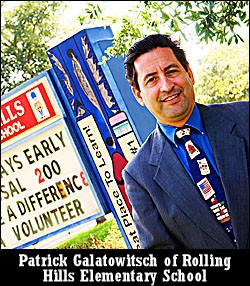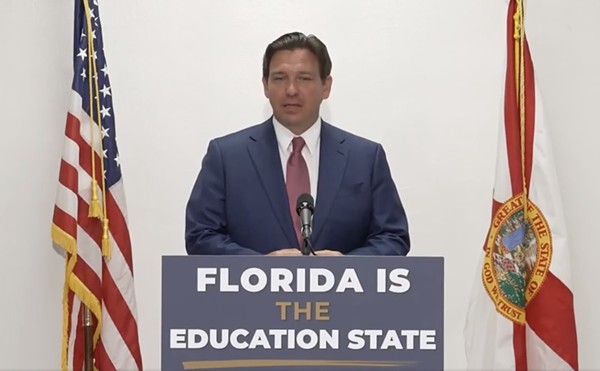Where are people who rate public-school educators as even less trustworthy than, say, real estate agents. Such people send their kids to schools with names that sound like country clubs: Park Maitland, Orangewood, Masters. When I tell such people that my daughter goes to public school they don't say, "Right on," or "Good for her!" They say, "What?" as though I'm sending her to insurgent training in Baghdad.
I am not one of those people. I am a Florida-certified teacher. I taught in two public schools and worked as an education consultant in the private sector from 1984 to 1998. During that time, I visited close to every single public school in Florida; in Central Florida, I visited most of them on a monthly basis.
So here is my – knowledgeable, but admittedly biased – assessment of the teachers and administrators who make up the public-school system in Florida: They work their butts off. And, despite what you may have read and heard, that hard work is paying off. Despite the fact that public education in Florida has a bad reputation, and despite withering attacks from the state and federal governments, it still works.
Need some figures to back that up? According to Education Week's ninth annual national edition of "Quality Counts 2005" (a survey which tracks state policies and information across key areas of education), Florida is among the top states when it comes to the number of teachers who are certified by the National Board for Professional Teaching Standards, a voluntary certification that goes beyond state-licensing requirements. Florida is one of only 12 states that earned an "A" in an Education Week survey for standards and accountability, and did so with less revenue inequities across communities than most other states. Yet Florida ranks 43rd in the nation in the amount of taxable assets used for educating its 2.5 million-plus students.
I spent some time this summer talking to administrators, teachers and parents about public education and came across some good examples of why it's premature to give up on the idea of public education.
SANFORD MIDDLE SCHOOL
In the Seminole County public schools, 65,705 students are still learning under a '70s-era desegregation order. The district offers alternative enrollment by lottery in racially disproportionate schools to balance demographics. One such magnet school, Sanford Middle, is an example of a school that works.
Voted Seminole County's assistant principal of the year in 2005, Mark Russi is taking the helm this fall at Sanford Middle, taking the place of the retiring Bill Gibson. Russi seemed relaxed about the prospect, sitting at a round table in his office recently.
"The district," Russi says, "is constantly looking at the direction we're moving. But we're not waiting for that. We're on the front end."
Sanford Middle has an impressive list of programs, and Russi can rattle them off: international baccalaureate, premedical, preveterinary, gifted, graphic design, digital photography. There are also four or five computers in every classroom, a flight simulator, a space simulator and a meteorology data station.
"When Bill `Gibson` came here," Russi says, "his thing was, 'You can't say these kids can't do something. You've got to offer it. We can't enable them not to perform.' Before `Bill` there weren't the elective programs that we have. There's a math camp going on right now. I don't know how many kids you know who want to go to math during the summer."
Sanford Middle has three national board-certified teachers, and a few more in training. The school also recruits professionals who want to go into teaching. "Our engineering teacher is an engineer," Russi points out. "She's also a certified teacher."
Drawing a diverse enrollment from as far away as rural Chuluota, Sanford Middle has more than 1,300 students; over half of them qualify for free lunch and a quarter of them may move before the end of the school year. These students scored a solid "B" ranking on the 2005 FCAT, and a "provisional" status for adequate yearly progress under the federal No Child Left Behind Act.
After checking out the flight simulator, I called Elizabeth Darcy, a language arts teacher and a parent whose daughter, Hannah, attended Sanford Middle. President of the Parent Teacher Student Association (PTSA) for two years, Darcy was honored with a lifetime membership for serving with distinction.
"I followed my daughter here. I said, 'Mr. Gibson, I'd love to work here.' I was so bold – but I like the diverse population, to be able to teach all the different groups. I like the number of electives provided, which stimulates them in math and science so they do better in their core subjects."
COLONIAL HIGH SCHOOL
Tremendous growth took place in Orange County public schools in 2004 and 2005. According to superintendent Ron Blocker, the district averages 7,000 new students a year. It is the 12th-largest school district in the nation, with 161 schools and 174,000 students. Of these, 200 nationalities and 160 languages and dialects are represented.
"The 1970s desegregation order doesn't reflect the diversity of the 21st century," Blocker says. "The world is different now. Orange County is different. It no longer has as many racially identifiable sections. ESOL `English for speakers of other languages` is no longer just Spanish; it's now 14 different languages."
Colonial High School is a microcosm of that diversity. Located off Oleander Drive on State Road 436, Colonial High has an enrollment of 3,700 students, many of whom are products of "generational poverty," according to principal Dr. Paul V. Mitchell. The student enrollment is a mixture of one-third white, more than one-half Hispanic and a minority African-American population.
A seasoned 32-year employee of Orange County public schools, Mitchell was in a staff meeting when I arrived, discussing education strategy for the 2005-2006 year. Back in his office, he had a PowerPoint display ready to demonstrate how Colonial climbed from a "D" to a "C" in one academic year.
"Have you seen the movie Coach Carter?" he asks. "There are a lot of similarities to our community."
To fight failure, his school devised administrative calendars divided by subject matter. Each calendar states individual objectives of the Sunshine State Standard benchmarks, the number of days required to teach it, sources used to teach it and the assessment method used to measure it. In addition, each objective is integrated with subject matter. "If a world history teacher is teaching 'main idea,' so is the English teacher," Mitchell says. "Even physical education teachers cover FCAT benchmarks." Teachers have magnetized benchmark banners which they post on white boards to review skill mastery.
Mitchell also implemented a tracking system devised by a Colonial High resource specialist, through a networked database that enables teachers, guidance counselors, FCAT prep teachers, assistant principals and Mitchell to check each and every student grade, every single week.
"If they do well, I buy them doughnuts, have a party. Sometimes we fuss at the kids, we call them in, tell them they have to bring their parents in. We try to find out their goals. I monitor every single one of them. They get after-school and Saturday tutoring if they need it."
In spite of all this, Colonial High did not make "adequate yearly progress" as defined by No Child Left Behind. Mitchell is philosophical.
"A big inner-city school like ours; the president had some pretty good ideas. FCAT, well … it made me think of education differently. I saw the "A Nation at Risk" study come out. … We moved into whole language `a controversial educational theory` in the '80s. Now we're swinging back to basics. I've always been about kids and learning. I'm real proud of our kids and teachers. It's a good community, good kids. I tell them to roll up their sleeves, and let's show them. It's a challenge."
MIDWAY ELEMENTARY
The Midway school was built in 1938 and was last renovated 15 to 20 years ago.
Midway is in a very poor neighborhood; 90 percent of the students at the school qualify for the free lunch program. It's one of the schools I used to visit monthly in the 1990s. When I walked in the door, the same receptionist I knew 10 years ago greeted me. A teacher I used to work with is still there, but beyond that everything is different.
Midway got a "C" rating in 2003-2004, and that was an accomplishment. This year they got a "B," and were only two points – one answer, one child – away from an "A."
An old school, a disproportionate minority population, poverty, mobility: Midway has it all. Yet Midway made average yearly progress in every category in 2004-2005.
"It means a lot," Dr. Sharon Tanner says. "I am more proud of that than anything else. I can go to bed at night and know that every child is learning."
An at-risk school calls for a combination of intense concentration to detail, a superior staff and a tireless champion for students. Tanner incorporates all three qualities. In fact, she is so energetic and upbeat that she makes me want to go home and put a wet towel on my head. Ten years ago, when the teacher I worked with at Midway and I struggled with "integrated learning systems," the educational concept of the day, we never achieved the results Tanner has achieved. "Technology is a piece, not the key," Tanner says. "My key is the teacher who walks through the door."
Tanner devised a system of assessment, intervention, data-driven analysis, professional development, motivation and reward to drive her students to their astounding results. "Seminole County allows schools to make decisions. So I decided that March `after FCAT testing` is the first nine weeks of our school year. The direction our state is going, our government is going – if they're going to use a high-stakes test to make or break a school, we're running from March to March with no downtime."
Elizabeth Jones is a second-generation Midway student with two children who attend the school. "I went there when I was a child and now I'm 35," she says. "I'm known by almost every person in that school. They know if they have a problem, they can call me. I'm not going to pass the buck.
"Charlie `Jones' son` has learning problems. He's also partially deaf. His teacher, Vicky Purnell, is the type that students with these issues need: firm, but with a lot of compassion. He was retained, a nonreader. She worked diligently with him. Charlie blew all of our minds when in second grade he went to a third-grade reading level. The staff and their compassion for learning make that school what it is."
ROLLING HILLS ELEMENTARY
"It may be an oversimplification, but in the right neighborhood, if you stay the course, all kids will do well," Orange County superintendent Ron Blocker tells me.
In the main office of Rolling Hills Elementary, I study the usual motivational rhetoric displayed on the walls: "The 3 Rs – Respect Yourself, Respect Others, Respect Your School" and "Committed to Excellence." There is a sign on the door of the guid- ance counselor's office that reads "peer mediation."
It's nothing special. Also, it's located in Pine Hills, which, let's face it, covers some hard-luck Orlando scenery. Yet Rolling Hills Elementary is the most pleasant school I visited.
The principal, Patrick J. Galatowitsch, leads me to his office and then wanders off to make some coffee. On the wall are pictures of him with Jeb Bush, George Bush and Laura Bush. In 2003, Galatowitsch was one of eight principals in the country invited to the White House to celebrate the first anniversary of No Child Left Behind. In the spring of 2004, his was one of six schools in the country to receive the Fordham University National School Change Award. He has a plaque from Jim Horne, of Department of Education notoriety, for outstanding leadership. This year he received Florida's National Distinguished Principal Award.
Galatowitsch put his palms on the desk, leans forward and says, "So what do you want to tell me?"
I wait a beat. "Actually, I want to ask you some questions."
"Oh." Understanding dawns on his face. "You're the writer. I thought you were a teacher. For an interview. I wish you were a teacher."
"Why?"
"We're desperate for teachers," he says.
Rolling Hills Elementary has 93 percent of its students on the free lunch program; 94 percent of the student body is minority. It also has a mobility rate of 87 percent, meaning that percentage of its students left during the school year last year.
"In any given week," Galatowitsch says, "we have anywhere from 20 to 40 students leave or enter our school. It's a revolving door. So it's very difficult, not only to keep track of the kids we have, but to monitor their progress as well. With an enrollment of 830, we're going to start the school year with 200 new students."
As if that isn't enough, the school is a center for emotionally handicapped students from all over the area.
Yet in 2003 and 2004, Rolling Hills was an "A" school. This year the school dipped to a "C" and did not make adequate yearly progress.
"The progress of our children is well above the bar. We're really an 'A' school," Galatowitsch says. "We dropped to a 'C' because the state changed their grading formula. Our reading grades stayed the same and our math went up, but because they raised the standard in writing and included students with disabilities in the grading formula – we included the educable mentally handicapped this year for the first time."
Orange County topped the state last year for improvement among the lowest-achieving 25 percent of students, a fact I mention to Galatowitsch.
He nods. "We had 15 mentally handicapped students. I think one showed improvement. It takes these students longer, it takes more time. This year we're targeting lots of resources towards those children. Expecting students with IQs in the 50s and 60s to reach upper levels of FCAT is a fantasy. Still, we're going to redouble our efforts. We have to overcome it, is the bottom line."
Galatowitsch has plans. Rolling Hills was selected by the state of Florida to be one of 400 schools nationwide to participate in the Successful Practices Network, an organization that specializes in raising achievement levels of exceptional student education (ESE) students. Also, he's going to have two teachers co-teaching in classrooms this year. One is a regular teacher, one is an ESE teacher.
"I believe that the bottom line is that standards have improved education. The AYP `average yearly progress standards` and A-Plus plan have improved schools. Even though they're confusing, I like them; they help me. I view it as an opportunity to target our resources towards children who haven't been as successful as they should be."
I get up to leave. "If you change your mind about teaching …" he says.
"I live too far away."
"I have a teacher who drives in from Cocoa Beach every day."
I don't doubt it.
NO HELP FROM ABOVE
Schools like the four above succeed despite a sustained effort by Gov. Jeb Bush to implement a statewide voucher program. One side of the argument says vouchers offer kids in failing schools a way out; the other says vouchers serve only to divert public funds to private, often religious, schools.
Vouchers amount to over $146 million taxpayer dollars. Parents who home-school their kids can receive voucher money.
"If we were adequately funded, I'd feel a little better about `vouchers`," says Blocker, the Orange County superintendent. "Ask any superintendent in Florida. We all feel that anything that takes money from what we have to do is a mistake."
Vouchers have been declared unconstitutional in the past. The question of whether or not they divert public funds to religious institutions is before the state supreme court right now.
And vouchers aren't the only threat to Florida's schools. I doubt there is a single public-school administrator who hasn't grasped the significance of Florida's public-school accountability system, which consists of Jeb Bush's A-Plus plan and George W. Bush's No Child Left Behind (NCLB) Act: a formidable double whammy. The former is the source of the letter grades we are all familiar with, which are based on FCAT results. The latter demands that, in addition to scoring well, schools make "adequate yearly progress," lest they lose federal funding.
Even if a Florida school receives a passing grade under A-Plus, it could still fail to make adequate yearly progress, as defined by No Child Left Behind. As one Central Florida administrator put it, "If one wanted to be pessimistic or realistic, depending on your view, it could be said that No Child Left Behind could be used to dismantle public education."
One student's progress on a test can make the difference between a school making average yearly progress or not. An outbreak of flu, which lowers attendance, can make the difference between a school making the benchmark or not.
What are the consequences for not meeting average yearly progress standards? For schools receiving federal assistance, there are escalating circles of hell: vouchers, possible takeover and private management.
"Let 'em," says one principal. "They can't do any better."
NO COMMENT
I'd like to have included a comment from Jeb Bush for this story, but he didn't respond to calls or e-mails. On the other hand, I heard back from almost every educator I called for this story, even though most of them were on summer vacation.
So I'll end this on my soapbox: Accountability is a good thing, intimidation is not. When every nuance of public education is controlled by a government that doesn't answer questions, and doesn't listen to the people who know the answers, the schools are in trouble.
I want to stop defending public schools, and I want them to stop having to defend themselves. Public opinion is a powerful tool, and it is shaped by many factors, pride and encouragement being two of them.
I'm still standing behind public education. I know I'm not alone.






















